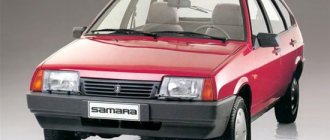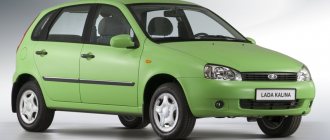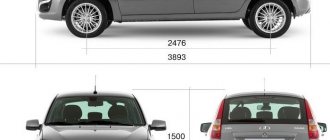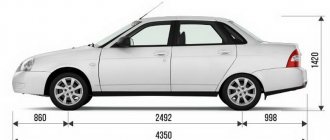Description
Lada Priora restyling 2013, hatchback 5 doors, 1st generation (10.2013 - 12.2015) - technical characteristics and equipment
LADA Priora station wagon (aka VAZ 2171) is a Russian passenger car with a station wagon body. Created on the basis of the LADA Priora sedan (VAZ-2170). Serial production of commercial vehicles began on May 27, 2009. By the end of May, according to the plan, 250 new station wagons were produced, and sales through the dealer network began on June 20, 2009. The Lada Priora station wagon is a deep modernization of the VAZ-2111 with a completely changed body design, including the rear part with original body panels and lighting equipment. The rear side windows are installed without plastic covers; their shape has changed (they expand upward). The rear lights from the door were moved to the body and installed in a vertical layout. There are brackets on the wheel arches of the trunk to secure the cargo.
Summary
Lada Priora communities lada priora club blog ignition switch wires
Otherwise, all the parts are fully functioning without any complaints. Naturally, there are exceptions to all rules and there are many cars with different problems. But as for the first generations, they are not worth buying on the secondary market. The build quality is frankly “lame”. If you follow the operating rules and properly maintain the car, it will serve its owner for quite a long time. Today these cars are sold on the secondary market - you can buy a VAZ-217030 in good condition. The instructions for the car will tell the owner about proper operation.
So, we found out what technical characteristics, design and interior the Lada Priora has.
Source
Power point
Lada Priora station wagon standard 21715-31-059 (12.2014 - 12.2015) - technical specifications
The engine used is the already familiar VAZ-21116 eight-valve engine. It is capable of producing 90 horsepower. Also in the line there is a 16-valve VAZ-21126 engine with a capacity of 98 “horses”. Various foreign-made components and parts were used in the design of the engines. Due to this, it was possible to significantly increase the overall resource of power units. Thus, a new, lightweight connecting rod and piston group from Federal Mogul was used. The timing belt, as well as the tension pulley for it, were manufactured by Gates. The manufacturer claims that the resource of the kit is more than 200 thousand km. In the maximum configuration, the VAZ-217030 comes with a 1.8-liter engine with a capacity of 120 hp. This version was suggested. But there are very few such copies. They were made to order.
pros
"Lada Priora", without a doubt, captivated many with its characteristics and price. However, its engine has a number of pros and cons, knowing which you can avoid many problems. Among the advantages are the following:
- Reliability. Yes, the Lada engine is far from the BMW, but it copes with the assigned tasks with a bang. Simple and good-quality, it can last up to 200 thousand kilometers, and after major repairs it can last the same amount.
- Cheap consumables. Engine parts can hardly be called cheap by definition, but repairs from Priora will cost much less than cars from foreign manufacturers.
- The power for a lightweight Lada 2170 is quite sufficient to accelerate at a sufficient speed. The 21126 engine with 16 valves can produce power up to 100 horsepower and reach speeds of up to 180 km/h.
- Environmentally friendly. The Priora engine fully complies with European quality standards and emits less exhaust gases into the atmosphere than its predecessors.
- Good traction at both high and low speeds appeared after modification of the exhaust manifold.
- The efficiency of the 16-valve engine is significantly greater than that of previous generations of Lada due to its design. Because of this, the car consumes less fuel.
As you can see, there are many advantages. It is not difficult to understand why the Lada Priora became so popular in Russia. The Russian-made car was created for our roads, and its design took into account all the pitfalls. But not a single thing can be ideal, so disadvantages can also be found in the VAZ-2170.
Impressions from real owners
Those who are just choosing a car to suit their taste strive to learn more about it from those car enthusiasts who have already driven hundreds of kilometers in this car. Reviews from Priora hatchback car owners in this case are quite important.
Most positive opinions about this car are based on the fact that it justifies itself. Of course, it does not reach the level of economy-class foreign cars, but at the same time it costs quite affordable and real money, it is also cheap to maintain, and spare parts for it can be easily found in a wide range.
In reviews of the Priora hatchback (VAZ-2172), the owners claim that it has a fairly roomy and comfortable interior and a modern appearance
The car itself is quite tall, which allows it to easily climb curbs and overcome potholes, which is very important if you take into account the specifics of domestic roads
When driving a car, even an inexperienced driver does not face any difficulties: everything is at hand, speeds are switched without unnecessary effort, and the visibility is as good as possible. The car accelerates well on the highway, maintaining a fairly high speed, and also has relatively economical fuel consumption.
In some reviews from real owners about the Priora hatchback, it is even called the most successful domestic model in many recent years. The only drawback that everyone without exception notices is the need, immediately after purchase, to properly secure the interior trim and maximize sound insulation. It is praised for its attractive design and appearance, as well as its efficiency, especially when it comes to moving around the city.
The decisive factor for many is that the machine is as easy to use and manage as possible. There is nothing superfluous, everything is only the most necessary. The standard on-board computer allows you to control the maximum number of parameters while the vehicle is moving. There is space for installing an audio and video center with a rear view camera. There is a convenient and reliable power steering. The engine runs smoothly and without interruption; in owner reviews of the Priora hatchback, everyone separately mentions that the car is easy to maintain, spare parts for it are inexpensive, and can be easily purchased anywhere.
Compared to other VAZ models, the trunk pleasantly surprises with its impressive size, even if you decide to opt for a hatchback. If necessary, you can even place a bicycle, fishing gear or a baby stroller in it.
Power point
The engine used is the already familiar VAZ-21116 eight-valve engine. It is capable of producing 90 horsepower. The line also includes a 16-valve engine with a capacity of 98 horsepower. Various foreign-made components and parts were used in the design of the engines. Due to this, it was possible to significantly increase the overall resource of power units. So, a new, lightweight one from Federal Mogul was used. The timing belt, as well as the tension pulley for it, were manufactured by Gates. The manufacturer claims that the resource of the kit is more than 200 thousand km. In the maximum configuration, the VAZ-217030 comes with a 1.8-liter engine with a capacity of 120 hp. This is the version I suggested. But there are very few such copies. They were made to order.
New car on an old platform
The tenth model began production in the late 90s. AvtoVAZ engineers already well understood that on the basis of the platform developed back in the 90s, nothing promising could be built, and very soon the car would become unclaimed. The worst thing is that it will be easily surpassed by foreign competitors with budget models. The primary task of AvtoVAZ specialists was restyling. By the way, the designers began working on the car’s appearance long before the model was put on the assembly line. Look what the pre-production VAZ-217030 looks like. Photos of the car can be seen below.
Configurations of Lada Priora VAZ 2170 and other modifications
VAZ 2170 is known in the following configurations:
- “Standard” is the most budget package. It lacks: audio radio, speakers, air conditioning, rear headrests, immobilizer, central locking, heated front seats, electric drive and heated exterior mirrors, fog lights, remote trunk release. The front windows are electric, the rear windows are mechanical. The engine is 81 hp, which has been discontinued since 2013, and at the moment there are no longer orders for this configuration;
- “Norma”, which is equipped with an 87-, and after restyling - only a 98- and 106-power engine. Available: audio preparation, on-board computer, electric heating and electric drive of exterior mirrors, immobilizer, anti-theft alarm and all the elements of the “standard” equipment plus some new equipment. This configuration is in greatest demand due to its price niche. When you need a car “yesterday”, you have to buy what you have enough money for now, and everyone else has to retrofit the car in the process.
- "Norma". Essentially, this is the same standard for which one or more items of equipment are set: air conditioning, audio radio with speakers, ABS BAS, child seat mounts, heated front seats and windshield;
- “Lux” is the most rich in functionality. It has everything that the “norm” has, and in addition: side airbags, an airbag for the front passenger, rear and front electric windows, a navigator, a multimedia system, cruise control, parking sensors, fog lights, a rain sensor, a climate system, alloy wheels, heated front seats;
- “Sport” is a special package that increases the “sports” component. This is an aerodynamic body kit: a pronounced bumper with a spoiler, side sills, a diffuser rear bumper, and a wing on the trunk lid. The wheels with narrow profile tires are also different. Ground clearance, curb weight (up to 1080 kg) and maximum weight (up to 1500 kg) have been reduced. The interior has also been transformed: side supports have been added along the edges of the seats with red stitched seams, carbon fiber inserts, and a leather steering wheel. Air conditioning, radio, and a full set of electric windows are included. However, the production of sports Prioras was limited and today they are discontinued, although they can be found here and there on the highway, and most often these are Priora coupes.
https://www.youtube.com/watch?v=ytdevru
Of course, this is not a complete, but only an indicative overview of the configurations of the Lada Priora, which is hardly possible to present in its entirety within the confines of one article. In addition, the equipment also differs somewhat depending on the body type. For example:
- Prior station wagons have roof rails, brackets on the wheel arches of the trunk, for which cargo can be strapped;
- For the coupe body, folding backrests and a reinforced frame of the front seats have been developed.
Engine
Lada Priora has undergone changes several times, both externally and technically. The appearance, power plant and transmission changed.
Below is an example of engines that were installed on the VAZ 2170-72.
Engine 21116 (8 valves)
This engine was installed on the VAZ 2114 and Lada Kalina, and was later inherited by the Priora. The power of this internal combustion engine is 80 hp. with a volume of 1.6 liters, which is very small. Such an engine does not have good dynamics, and it is difficult for it to “drag” the body of the Priora.
Pros:
- Does not bend valves;
- Easy to maintain;
- Cheaper spare parts;
Minuses:
The installation of such an engine continued until 2022.
Engine 21126 (16 valves)
16 valve engine with more power and torque compared to 116. It is a modified model of the 124 engine. Its power is 98 hp. with a volume of 1.6 liters.
Pros:
- Great power;
- No noisy operation;
Minuses:
- Bend valves when the belt breaks;
- Expensive spare parts;
Engine 21127 (16 valves)
The modified 126 engine received the index 21127; the intake in this engine was changed, thereby increasing the power to 106 hp. with the same volume of 1.6 liters. They began to install a new cable gearbox for this engine.
Pros:
- High power;
- No noisy operation;
Minuses:
- Bend valves;
- Expensive spare parts;
Engine 21128 (16 valves)
This engine was specially designed for more powerful Lada cars with the “Super Auto” nameplate. The power of this engine has increased, as has its volume. The number of horsepower in the super car engine increased to 123, and the volume to 1.8 liters, which radically affected the dynamics of the car.
Pros:
Good dynamics and high power;
Minuses:
- Bend valves;
- More expensive spare parts;
Design features
The main part of the engine, the cylinder block (catalog number 11193-1002011), also differs in size from its predecessor. It is factory painted blue. Its height, the distance from the crankshaft axis to the upper plane, became 197.1 mm, versus 194.8 mm on the 2112 model.
The dimensions of the holes for the block head mounting bolts have changed; they are from the hoist with M10×1.25 threads. The main bearing supports on the 124th engine, from the second to the fifth, are equipped with channels designed to supply oil that cools the piston during operation.
The crankshaft installed is the same as on models 21126 and 11194, with the marking 11183 cast on the sixth counterweight. Due to the crank radius of 37.8 mm, a piston stroke of 75.6 mm was provided. A toothed pulley is installed on the shaft for timing belt drive. The belt is 25.4 mm wide and has 136 teeth, parabolic in shape. Belt service life is 45,000 km.
The pulley is designed to drive additional units using a V-belt. Three types of belts are used, differing in length, depending on the equipment:
- If the drive is only for the generator, the belt length is 742 mm.
- With power steering - 1115 mm.
- With power steering and air conditioning 1125 mm.
The pulley is designed in such a way that it acts as a damper, reducing the torque loads acting on the shaft. Another function is to determine the position of the crankshaft using a sensor and a gear mounted in the damper.
On previous VAZ 16v models without recesses or with recesses of shallower depth, in such a situation there was a risk of bending the valves, which led to expensive repairs. So, concerns and frequently arising questions about whether the valves bend on this engine have been removed.
Oil scraper and compression rings are made of steel or cast iron. The pistons and connecting rods are connected using floating pins, 22 mm in diameter, 60.5 mm in length, secured with retaining rings. The pins and connecting rods are borrowed from the VAZ 2110 modification.
The block head for the 16 valve LADA 21124 engine has an enlarged docking area for the intake manifold flange. Both camshafts for the exhaust and intake valves, as well as the valves themselves, springs, and hydraulic compensators have also been preserved from the previous modification of the engine.
In order to avoid confusion, the shafts are marked with a digital code. If it ends at 14, then this is the exhaust valve shaft, if at 15, then this is the intake shaft.
Another difference is that there is a raw strip on the intake shaft, next to the first pushrod. By adding hydraulic compensators to the design, the manufacturer eliminated the need to maintain valves in terms of adjustment. But, they are very sensitive to the cleanliness and quality of the lubricant. Low-quality oil will quickly damage parts and must be replaced; such repairs are not provided for the VAZ 124.
The spring-valve group is similar to model 2112. Valves with one spring and rods with a diameter of 7 mm (on eight-valve heads their diameter is 8 mm). Toothed pulleys with marks for setting the valve timing are installed on the camshafts. Compared to model 2112, the marks are shifted relative to each other by 2°.
Just like the shafts, the pulleys have differences in design and markings - on the inlet, a strip is welded on the back side, on the outlet it is missing. Both pulleys have markings in the form of circles on the hub.
Correct belt tension is done using support and tension rollers with flanges (to eliminate the possibility of slipping).
The cylinder head gasket is made from asbestos-free material. The holes for the cylinders are made with metal edging.
The intake manifold is combined with the receiver and is made of plastic.
For the first time in cars of the VAZ 2110 family, a catalytic converter was installed, combined with an exhaust manifold. Depending on what EURO 4 or 5 requirements the 124 motor is designed for, a different type of collector is installed.
The design of the fuel rail was updated and it began to be made from stainless steel. The drain line was removed from the fuel system; instead, a bypass valve was installed on the pump to relieve excess pressure. To supply fuel directly to the cylinders, nozzles manufactured by Bosch and Siemens were used.
The ignition coils were installed on spark plugs, each spark plug had its own individual coil, with additional fixation to the valve cover. With this method, high-voltage wires were no longer needed, and the ignition control began to be carried out by Bosch M7.9.7 or Russian January 7.2 control units, intended for EURO-4 and 3.
Technical parameters and interior of the VAZ 2170
The two modifications differ almost only in engines. The remaining technical characteristics of the VAZ are identical. The first version of the car has a built-in 8-valve petrol engine 21116 with a volume of 1.6 liters. Fuel is supplied electronically and the 4 cylinders are arranged in a row. The maximum power of 87 forces is achieved at 5100 rpm, the maximum torque is 140 Nm, the highest speed is 176 km/h. The car does 100 in 12.5 seconds. Gasoline consumption: 9.0/5.8/7.0 liters, respectively, in the city, on the highway and in the combined cycle. The fuel tank with a volume of 43 liters must be filled with A-95 gasoline.
The second modification of the car is equipped with a 16-valve 106-horsepower gasoline unit 21127 with a volume of 1.6 liters. To develop maximum thrust, 5800 engine rpm is required. The maximum torque is 148 Nm, and the acceleration time to hundreds is 11.5 seconds. The main source of electricity is the 2170 generator, which has an adjustable voltage of 13.8 - 14.4 V.
The Lada Priora is equipped with a 5-speed manual transmission with a gear ratio of 3.7. The front has a semi-independent suspension with MacPherson struts, springs, shock absorbers and a stabilizer bar. The rear suspension is semi-independent with levers, springs and shock absorbers. Shock absorbers in both cases are hydraulic or gas-filled telescopic.
Wheels and tires are different for the two Priora modifications. The car with an 8-valve engine has 13-inch wheels. The model with a larger engine, depending on the configuration, can be “shod” with tires with rims of 13 or 14 inches.
Tires of various modifications are represented by the formulas 175/70 R13 (82, T); 175/65 R14 (82; H), The marking is deciphered as follows: 175 - tire width, mm; 70 (65) — ratio of tire profile to width in%; R — tire type (radial); 82 and T, respectively, are the load and speed index.
The interior of the VAZ Priora is distinguished by good spaciousness. When getting into the cabin, a person taller than average can fit comfortably in height; their legs also do not rest against the back of the front seat. The upholstery of the chairs is made of high quality fabric.
6.1.1. Design Features
| Rice. 6.1 . Clutch: 1 – cable tip guide; 2 – clutch release fork lever; 3 – clutch casing; 4 – bolt securing the clutch to the flywheel; 5 – pressure disk; 6 – flywheel; 7 – driven disk; 8 – gearbox input shaft; 9 – front cover of the clutch housing; 10 – clutch housing; 11 – pressure spring; 12 – clutch release bearing |
The clutch is single-disk, dry, permanently closed, with a central pressure spring 11 (Fig. 6.1, 6.3) and a torsional vibration damper on the driven disk 7. The clutch housing 3 is attached to the flywheel 6 with six bolts 4, and is connected to the pressure disk 5 by three pairs of elastic plates .
| Rice. 6.2 . Clutch release drive: 1 – cable guide; 2 – clutch release fork; 3 – fork axle bushing; 4 – cable; 5 – seal; 6 – clutch pedal bracket; 7 – cover; 8 – locking bracket; 9 – bracket; 10 – bushing; 11 – bushing for the clutch pedal axis; 12 – clutch pedal axis; 13 – clutch pedal; 14 – clutch pedal pad |
The clutch release drive is cable, backlash-free (there are no gaps in the drive). Cable 4 (Fig. 6.2) of the clutch release drive is equipped with a ratchet-type mechanism designed to compensate for the length during operation when the driven disk linings are worn (adjustment of the drive in operation is not required). Clutch pedal 13 is installed in bracket 6, mounted on the front panel, on the axle through two plastic bushings. The upper part of the pedal is connected to the housing of the clutch wear compensation mechanism. The upper end of the cable sheath is secured to the clutch pedal bracket using a plate stop, and the lower end of the cable is secured to a bracket mounted on the gearbox housing. Plastic leash 1 (see Fig. 6.1) of the lower end of the cable is connected to lever 2 of the clutch release fork. The clutch release bearing 12 is a closed type and does not require lubrication during operation. The main parameter that determines the operation of the clutch release drive is the travel of the clutch pedal all the way to the floor mat. The pedal travel is not adjustable in operation; it is ensured by a structurally sound mechanism for compensating wear on the clutch plate linings and correct initial installation of the drive cable (see “Replacing the clutch release cable”).
| Useful tips In order for the clutch to serve for a long time and without failure, do not constantly keep your foot on the clutch pedal. This bad habit is often acquired while learning to drive in driving schools for fear of not having time to disengage the clutch while stopping the car. In addition to the rapid fatigue of the leg, which is always above the pedal, the clutch is depressed at least a little, and the driven disk slips and wears out. In addition, although the release bearing is designed to operate in constant rotation mode, when the pedal is pressed even slightly, it experiences increased load and its service life also decreases. For the same reason, we do not recommend keeping the clutch disengaged for a long time (for example, in traffic jams). If you don’t have to move away right away, it’s better to put the gearbox in neutral and release the pedal. Clutch slippage can be easily determined using a tachometer. If while driving, when you sharply press the accelerator pedal, the speed rises sharply, and then drops slightly and the car begins to accelerate, the clutch requires repair. |
Dashboard
Here specialists from an Italian studio changed everything beyond recognition. There is now an on-board computer in the central part. It has been significantly improved. There is an electronic odometer, fuel consumption sensor (average and instantaneous), clock, average speed and other data. For some reason, the trunk opening button was moved to the central tunnel, closer to the gearbox selector. The trunk is quite large. Its useful volume is as much as 430 liters. You can open it from the passenger compartment, or from the alarm key fob. There is no separate button on the trunk lid. Depending on the configuration, a radio may be located in the center console. On newer modifications of Priora, multimedia systems with touch screens are installed. The buttons for controlling the power windows are now located on the doors, and not on the central tunnel, as before. The mirrors are electrically adjustable and heated.
Quality finish
As for finishing materials, the plastic of the front panel is quite soft. However, its quality is low. The steering wheel is not very good. It is made of inexpensive and frankly unpleasant to the touch plastic. It's not very convenient to use the steering column switches. One of the shortcomings of the interior organization is the high armrest in front. Because of this, working with the gear selector is very inconvenient. It is recessed into the central tunnel. The back row is comfortable - passengers will be comfortable. But this is true as long as people of average height sit in front of them. Two passengers can feel comfortable on the back seat. But if you make room, three will sit easily.
Tuning
Although the appearance of the Lada no longer looks downright old, and the level of comfort inside has increased after the next update, many car owners strive to make their car stand out from the crowd. Others want to improve the dynamic performance of Russian cars.
Engine tuning
Despite the fact that the car has a 16-valve engine, which is much more dynamic and powerful than previous versions, you still want to make your vehicle faster. A supercharger compressor comes to the rescue, increasing the power and thrust of the “engine” by 30-50 percent. Installation can be done using fastening units attached to the crankshaft pulley. Power increases due to the enrichment of the fuel-air mixture.
However, do not forget that after this, the “appetite” of the engine will increase significantly, so the fuel system will wear out faster and accumulate paraffin. You can resort to turbocharging. In this case, the efficiency increases, but more fuel is consumed. A mechanical supercharger (supercharger) takes part of the power from the engine, and the turbocharger operates only using exhaust gas energy.
It is also possible to increase the design volume of the cylinders - it will be possible to increase the power of the power unit without any difficulties. Such work is carried out after boring the cylinder blocks.
Appearance tuning
This generation is quite new, so in many cases the car does not require modification, but the car can be transformed with tuning. Some drivers decide to install a hood on stops instead of the outdated hood with a “poker,” which is very convenient. Many people know that the entire AvtoVAZ is “sick” with sound insulation, mainly in the doors.
It is planned to replace locks with a vibration-absorbing structure, where noise-absorbing type bolts are supplied. To enhance the effect, you can use a noise-absorbing material that softens the impact after closing the doors. Owners of Lada Priora use a vinyl base, which is very popular nowadays, to decorate their appearance. If you can spend more money, you can purchase airbrushing.
Some owners purchase a chrome base. Carbon-coated film looks good on any car, especially the new generation film. There is now a new 3D carbon film that imitates a carbon fiber coating throughout the body. The younger generation resorts to stylish body kits for their cars. This includes a spoiler, which gives the sedan a sporty look and improves aerodynamic performance.
Fans of high-quality exhaust system sound can be advised to install a new muffler that has power and a beastly look. You can also install improvements regarding the headlights, for example, angel eyes, eyelashes, and so on.
Tuning the interior
You can install more comfortable sports-type seats, LED lighting for various parts of the interior, buy new covers, and so on. Some drivers install buttons on the transmission tunnel.
Many car owners are dissatisfied with the standard interior lighting, so you can demonstrate standard lamps and place an LED strip there
It is important not to overdo it, otherwise the whole interior will be in bright colors and this can even be distracting
Recommendations for improvement
For the first time, they decided to increase the power of the new Priora 21126 engine at the factory in order to create a sports modification of it. Camshafts with increased lift, a lightweight connecting rod and piston group were installed, and the intake and exhaust tracts were modified. This is how the first domestic sports unit appeared, which was put into production, and they began to install it on the Lada Granta Sport model.
The technical characteristics of the engine are as follows: engine power from the Priora has increased to 118 hp. torque - up to 154 Nm at 4700 rpm, fuel consumption also increased to 7.8 liters per 100 km with a combined driving cycle. We will give a number of recommendations on how to independently increase the power of Priora engines:
- The simplest and most affordable way is to install a zero-resistance exhaust tract. The essence of its work is to reduce the resistance of the path, as a result of which some of the power spent on overcoming this resistance will be released and become useful.
- The same operating principle applies to the zero-resistance intake tract. Installing the receiver and throttle valve to 56 mm will allow the power unit to “breathe” more freely, and your Lada Priora will become several horsepower more powerful.
- Deeper tuning - new camshafts with a sports configuration, allowing the intake and exhaust valves to open more. This will give a noticeable increase in the agility of the car, especially in city conditions.
- Replacing the standard valves and connecting rod-piston group with a lightweight one will again release some of the useful energy of the unit and add it to the main power. Here you can kill two birds with one stone: install pistons with recesses, thereby eliminating the possibility of them “meeting” with the valves when the timing belt breaks.
- We should not forget about CHIP tuning. After major changes in the engine configuration, its operating mode will definitely improve, and in order to optimize it and adjust fuel consumption, you need to do a flashing.
Tuning Time: VAZ 2170 Priora (turbo) 250 hp.
How many horses can Priora have in addition to this? Quite a lot, there are capabilities and components to increase the power ultimately to 400 hp. This is due to a radical modification of the power plant: boring the cylinders, grinding the cylinder head, replacing the injectors and fuel pump with more efficient ones, installing four throttle valves and a turbocharger.
We should not forget about modernizing the brake system. Such tuning will give excellent results in terms of power, but the engine life will be significantly reduced, and fuel consumption, on the contrary, will increase significantly.
Restyling Lada Priora 2022
The 2022 restyling included some changes regarding the appearance, some equipment, interior and engine. Among such changes in Prior we will name:
- A slightly modified exterior geometry, which, however, makes no sense to describe, since visually Priora before and after restyling remained almost indistinguishable in appearance;
- Replacing the radiator grille with an elongated “honeycomb”, slightly tilting the car into the now fashionable “organic” style, characterized by biological forms;
- Improved external lighting technology, thanks to which the car’s dimensions have become clearer in the dark. In particular, the area of the reflectors has been increased, LED sections for side lights and brake lights have been added, which are both brighter and more responsive when switched on;
- A dashboard that is implemented differently: instead of four “dials,” the sensor arrows were arranged in two, without compromising functionality. Purely aesthetically it looks better, but from an ergonomic point of view, a lot depends on habit;
- An increased number of pictograms flashing on the dashboard, making it easier to figure out which lighting equipment is faulty;
- An added niche in the center of the dashboard, in which the on-board computer is placed;
- Extended front seat slides, allowing tall drivers and front passengers to adjust their seat positions more flexibly;
- A box that is more spacious in depth to the right of the driver;
- A more attractive three-spoke steering wheel with an airbag under a triangular cover;
- In the “luxury” configuration – leather upholstery based on a combination of auto fabric and eco-leather;
- New door card design.
Also, from 2022, Priors are available in a different engine configuration, from which the 80-horsepower engine was removed, but a new 106 l/s engine was added, which, like everyone else, reaches speeds of up to 183 km/h and reduces fuel consumption to 6. 8 – 6.9 liters per hundred km. This engine is equipped with the “luxury” configurations of the Priora.
Of course, this reduction in fuel consumption is very attractive to the consumer. We can only hope that the developers will continue to work in this direction. In addition, the new engine fits well into Euro-3 and Euro-4 environmental standards, thanks to the closely located catalyst. Due to rapid heating, the catalysis of toxic substances occurs more vigorously, as a result of which a lower concentration of them enters the atmosphere.
The restyled Prior also has a drawback (compared to previous editions of this car): the carpet in the trunk is thinner than its predecessors, which is why the noise level while driving is higher. Motorists are advised to take care of additional sound insulation in the trunk. In addition, the curb weight of the car has increased (to 1185 kg), which is by as much as 100 kg. reduced its cargo capabilities, since the maximum weight remained the same - 1593 kg. for a station wagon, and 1578 kg. for other body variations.
Differences from previous generation models
In reviews of the Priora hatchback, everyone noted its main differences from the Lada 110, which was actually the predecessor of this family. “Priora”, in fact, became an example of its deep restyling.
In total, about one thousand changes were made to the design, most of which were fundamental. About two thousand new parts were used during assembly. Interestingly, approximately the same amount was spent on creating a completely new model.
In reviews of the Lada Priora hatchback, car owners noted that the designers managed to correct the most serious mistakes made earlier in the design when the so-called tenth Lada family was created. For example, the clear boundary between the body and the roof in the area of the C-pillar, characteristic of the “ten,” is a thing of the past. According to most experts, it looked completely unnecessary and out of place in a small and wedge-shaped car. As a result, the transition was smoother. Gone are the ridiculously shaped rear wheel arches, which were previously repeatedly criticized. They were replaced with more presentable and aesthetic ones. The strip of rear lights from one side to the other, which was considered completely meaningless for such a narrow and compact car, was also removed. Instead, only two lights were left, located on the sides of the trunk lid in a vertical plane. Visually, this made it possible to increase the width of the car. Errors in the proportioning of some elements of the plastic, sidewalls and design were eliminated, which made it possible to move away from the negative image, which was popularly dubbed the “pregnant antelope”. If only for this reason, there were much more positive reviews about the Lada Priora hatchback than about its predecessor.
Lighting technology and a spoiler built into the trunk lid have become more modern. It was also possible to improve technologies for assembling mechanisms and components, which halved the gaps between body elements. As experts noted, in general, the design of the entire car went back to the appearance of the “ten”, which was created back in the 80s in accordance with the trend of biodesign that was fashionable at that time.
Italian specialists were involved in the development of the interior. An instrument panel with a trip computer, an armrest with niches for small items, and a silver console trim with an unusual oval-shaped clock appeared. Among the shortcomings in reviews of the Priora hatchback, car owners noted the short length of the front seat slides, which made tall drivers and passengers feel uncomfortable (even with a height of 175-180 centimeters). In addition, there was no full adjustment of the driver's seat; the steering column could only be adjusted in height.
Exterior
VAZ-217030 was created as a deep restyling of the VAZ-2110. First of all, the designers tried to remove excess weight around the rear axle. It soon became clear that without drastic changes to the front and rear, a new model would not be possible. A banal replacement of the bumper or optics will not solve the problem, and the heaviness in the appearance of the car will not be removed. The body seemed “heavy” due to the low rear wheel arches and the rear bumper, which was vertically connected to the rear wing. The designers tried to enlarge the wheel arches and create a rear bumper that extended from the rear edge of the car to the wheel arches. In addition to the design that everyone knows, there were two more options for restyling the VAZ-217030. Photos (including BPAN) can be seen in our article. From the tenth model, only the side part and doors remained. At the same time, the manufacturer claims that the doors have become wider by 5 millimeters. From the front and rear the car became almost unrecognizable. New optics installed. The hood, trunk lid and other exterior elements were also replaced. In general, the design can be easily compared with some budget Korean or Chinese models.
Transmission
The gearbox on the Priora was largely mechanical, and only in 2014, a robotic gearbox was installed in the luxury trim levels of the car.
Manual transmission
The manual gearbox received 5 steps and went to the Priora from the VAZ 2110; over time, namely in 2014, a cable gearbox replaced the conventional gearbox on the wing. The cable-based gearbox made it possible to reduce vibrations from the lever and make gear shifting more precise. Other parameters in the checkpoint have not changed.
Robotic gearbox
This gearbox is a development of AvtoVAZ. The model of this gearbox is called AMT 2182 and has 5 stages with cone synchronizers. The disadvantage of the gearbox is the frequent failure of the clutch actuator.
Specifications
Below we will talk about each element of the Lada Priora separately, namely, we will consider separately the body, engine, trunk, etc.
Body
Priora was produced in several bodies. In 2007, only a sedan appeared; later, in 2008, the first hatchback and station wagon rolled off the assembly line.
Sedan 2170
This body turned out to be very nice and most popular among young people. Young people started buying Priora and subjecting it to various tunings. It became a kind of youth movement.
Station wagon 2171
This type of body is an excellent solution for family people. The station wagon is equipped with a huge trunk.
Hatchback 2172
The hatchback does not differ from the sedan in technical characteristics and the front part of the body, but is shorter by several centimeters, which is noticeable to the naked eye.
Engine
Several types of engines with different power and number of valves were installed on the Lada. The table below shows all installed engines and their characteristics.
| Model | 21126 | 21127 | 21116 |
| Number of valves | 16 | 16 | 8 |
| Power (hp) | 98 | 106 | 87 |
| Type | Petrol | Petrol | Petrol |
| Torque, |
145/4000 148/4200 140/3800 Number of cylinders 4 4 4
Cylinder arrangement In-line In-line In-line
Volume (cubic cm) 1596 1596 1596
Fuel Gasoline AI 95 Gasoline AI 95 Gasoline AI 95
Power type Electronic injection Electronic injection Electronic injection
Maximum speed, km/h 183 183 172
Acceleration time to 100 km/h 11.5 11.0 12.5
Average fuel consumption per 100 km 7.2 7.2 7.6
Gear box
Priora was equipped with several gearboxes depending on the configuration and year of manufacture of the car. All gearboxes are 5-speed
Gearbox with rocker
This gearbox was installed on cars from 2007 to 2013. It is a fairly reliable and unpretentious gearbox, its main “soreness” is the weak second gear, which begins to fly out over time.
Cable gearbox
Installed on cars since 2014. Received a large number of positive reviews, the position of the gears, namely the reverse gear, has changed. The vibrations transmitted to the cabin from the gearbox have been reduced.
Robotic gearbox
In 2014, luxury car models began to be equipped with a robotic gearbox. It is very reliable and unpretentious, but noticeably loses in dynamics compared to a manual transmission.
Lada modifications of the sedan of the Priora car are the pioneer of the brand, code 2170. Russian budget city car, produced by AvtoVAZ from 2007 to 2022. Over the years, the car has been mass-produced in four bodies: sedan, hatchback, station wagon and coupe. Each of these versions found its buyer among certain groups of car enthusiasts, and the Lada Priora sedan even in popular culture. Remember the song: Lada Sedan eggplant!
The car has a balanced weight of 1088 to 1185 kg and engine power, making it dynamic. At the same time, fuel consumption does not exceed 9-10 liters. Which is appropriate for the city! The price of the entire car also hit the bull's eye. Over time, people preferred to buy a new car instead of a foreign car that was 20 years old.
The Priora sedan became the first car option for young drivers. All impressions boil down to the fact that for its class the car is comfortable, ergonomic and, moreover, smoothly goes over bumps and is inexpensive for spare parts.
Price
The basic version of the car will cost the buyer 424,900 thousand rubles. The maximum price for the Image configuration will be 533,400 thousand rubles. It is worth noting that the cost of maintenance and spare parts for domestic cars is quite low, which is their undoubted advantage.
| # | Equipment | Model years | Cost, rub. | Drive unit | Transmission | Engine, cc. cm | Acceleration from 0 to 100, s | Max. speed, km/h | Power, max., hp (kW) at rpm | Fuel consumption in the combined cycle, l/100 km |
| 1 | Standard0 | 2016 — 2018 | 424 900 | Front | Manual transmission 5 | 1596 | 12.5 | 176 | 87 (64) / 5100 | 7,3 |
| 2 | Standard0 | October 2013 - 2014 | 347 600 | Front | Manual transmission 5 | 1596 | 12.5 | 176 | 87 (64) / 5100 | 7,3 |
| 3 | Norma4 | 2015 - December 2015 | 454 300 | Front | Manual transmission 5 | 1596 | 11.5 | 183 | 98 (72) / 5600 | 6,9 |
| 4 | Norma7 | 2014 - December 2015 | 446 300 | Front | Manual transmission 5 | 1596 | 11.5 | 183 | 98 (72) / 5600 | 6,9 |
| 5 | Norma4 | 2014 — 2015 | 449 000 | Front | Manual transmission 5 | 1596 | 11.5 | 183 | 98 (72) / 5600 | 6,9 |
| 6 | Norma3 | October 2013 - 2014 | 409 700 | Front | Manual transmission 5 | 1596 | 11.5 | 183 | 98 (72) / 5600 | 6,9 |
| 7 | Norma9 | October 2013 - 2014 | 395 000 | Front | Manual transmission 5 | 1596 | 11.5 | 183 | 98 (72) / 5600 | 6,9 |
| 8 | Norma5 | October 2013 – November 2014 | 375 400 | Front | Manual transmission 5 | 1596 | 11.5 | 183 | 98 (72) / 5600 | 6,9 |
| 9 | Norma7 | October 2013 – November 2014 | 389 700 | Front | Manual transmission 5 | 1596 | 11.5 | 183 | 98 (72) / 5600 | 6,9 |
| 10 | Lux6 | October 2013 – December 2014 | 459 700 | Front | Manual transmission 5 | 1596 | 11.5 | 183 | 98 (72) / 5600 | 6,9 |
| 11 | Norma4 | October 2013 – December 2014 | 392 400 | Front | Manual transmission 5 | 1596 | 11.5 | 183 | 98 (72) / 5600 | 6,9 |
| 12 | Comfort8 | 2018 — 2018 | 522 400 | Front | Manual transmission 5 | 1596 | 11.5 | 183 | 106 (78) / 5800 | 6,8 |
| 13 | Image8 | 2018 — 2018 | 533 400 | Front | Manual transmission 5 | 1596 | 11.5 | 183 | 106 (78) / 5800 | 6,8 |
| 14 | Norm Climate8 | 2018 — 2018 | 513 900 | Front | Manual transmission 5 | 1596 | 11.5 | 183 | 106 (78) / 5800 | 6,8 |
| 15 | Norma Black Edition7 | 2016 - December 2017 | 499 900 | Front | Manual transmission 5 | 1596 | 11.5 | 183 | 106 (78) / 5800 | 6,8 |
| 16 | Norm Climate7 | 2016 - December 2017 | 488 900 | Front | Manual transmission 5 | 1596 | 11.5 | 183 | 106 (78) / 5800 | 6,8 |
| 17 | Norma White Edition7 | 2016 - December 2017 | 499 900 | Front | Manual transmission 5 | 1596 | 11.5 | 183 | 106 (78) / 5800 | 6,8 |
| 18 | Norma5 | 2016 — 2018 | 473 600 | Front | Manual transmission 5 | 1596 | 11.5 | 183 | 106 (78) / 5800 | 6,8 |
| 19 | Lux5 | 2016 — 2016 | 437 700 | Front | Manual transmission 5 | 1596 | 11.5 | 183 | 106 (78) / 5800 | 6,8 |
| 20 | Lux7 | 2016 — 2016 | 474 000 | Front | Manual transmission 5 | 1596 | 11.5 | 183 | 106 (78) / 5800 | 6,8 |
| 21 | Lux1 | 2015 - December 2015 | 506 300 | Front | Manual transmission 5 | 1596 | 11.5 | 183 | 106 (78) / 5800 | 6,8 |
| 22 | Norma5 | 2014 - November 2014 | 383 000 | Front | Manual transmission 5 | 1596 | 11.5 | 183 | 106 (78) / 5800 | 6,8 |
| 23 | Lux1 | 2014 - December 2015 | 506 300 | Front | Manual transmission 5 | 1596 | 11.5 | 183 | 106 (78) / 5800 | 6,8 |
| 24 | Norma5 | 2014 - December 2015 | 435 000 | Front | Manual transmission 5 | 1596 | 11.5 | 183 | 106 (78) / 5800 | 6,8 |
| 25 | Norma7 | 2014 - December 2015 | 449 300 | Front | Manual transmission 5 | 1596 | 11.5 | 183 | 106 (78) / 5800 | 6,8 |
| 26 | Lux3 | October 2013 – November 2014 | 449 700 | Front | Manual transmission 5 | 1596 | 11.5 | 183 | 106 (78) / 5800 | 6,8 |
| 27 | Norma8 | November 2015 – December 2015 | 447 000 | Front | Manual transmission 5 | 1596 | 12.6 | 183 | 106 (78) / 5800 | 6,6 |
| 28 | Lux6 | 2015 - December 2015 | 532 300 | Front | Manual transmission 5 | 1596 | 12.6 | 183 | 106 (78) / 5800 | 6,6 |
| 29 | Norma9 | November 2014 – December 2015 | 480 000 | Front | Manual transmission 5 | 1596 | 12.6 | 183 | 106 (78) / 5800 | 6,6 |
| 30 | Lux3 | 2014 - December 2015 | 526 300 | Front | Manual transmission 5 | 1596 | 12.6 | 183 | 106 (78) / 5800 | 6,6 |
* — information on prices is for reference only. Check with your local dealer for exact pricing.
The exact release date of the Lada Priora 2022 is not yet known, but according to preliminary data, this will happen in the first months of 2022. It is planned that, in addition to the Russian market, it will also enter the markets of neighboring countries.
This model is a long-liver of modern AvtoVAZ. If we evaluate the attitude of the owners of the previous generation Priora and the updated characteristics of the next year’s model, then we can assume that the reviews will be positive about the new 2019 product.
According to preliminary data, the latest version will be the final version in the production of the Lada Priora, since AvtoVAZ is currently modernizing the Lada Kalina and producing the Niva SUV.
Exterior
Just 2 years later, in the fall of 2013, AvtoVAZ again decided to update this model, but in this case the changes affected many elements. The company's specialists only retouched the appearance a little - they added DRLs to the front lighting, and the rear part received LED lights.
But inside the changes affected a lot. The interior itself received a new design, seats with a revised configuration and other finishing materials. The update also affected the technical stuffing - the driving performance of the Lada Priora was improved, the noise insulation was improved and a stability control system was installed. The three-volume car looks quite modern according to current criteria, but still the similarity with the “ten” model can be traced, mainly in profile.
The nose area of the VAZ car has teardrop-shaped optics (it didn’t go as far as lensed) with DRLs, a pentagonal radiator grille with honeycomb-shaped cells and a chrome frame. As for the front bumper, it received a moderately embossed shape and a “mouth” of the air intake, as well as fog lights spaced on the sides (in more expensive trim levels).
The side area of the new Priora model is devoid of any hints of a sporty bias, but it looks good with a sloping hood, an almost flat roof line and a protruding luggage compartment at the rear. The sirloin has a fairly simple design - you shouldn’t expect any designer frills. It has LED lights for side lights and brake lights, as well as a neat bumper with a plastic insert at the bottom. The ground clearance is 165 millimeters.
Car history
The company began preparing for the production of this machine back in 2006. The Lada management decided to replace the VAZ-2110 and all the cars of the 10th division with something new, and in 2007 the company presented the first thousand vehicles of the new generation. Many call this release a major restyling of the VAZ-2110.
Already in 2007, the company supplied its cars for sale. From the very beginning, cars were sold only as a sedan. A little later (in 2008), a hatchback version entered the market. The very next year a new Priora came out as a station wagon. Later, the car market was replenished with a coupe version. The company even planned to produce this car as a convertible.
It is worth noting that the Lada Priora successfully supplanted the 2110 from release. The number of sales immediately began to grow. Later, it was the Lada Priora that was seen more often on the road than the “ten”. But Priora is no longer produced, because it was replaced by the new Lada Vesta. The debut sedan Lada Priora 2007 was not as beautiful as it is today, but the car sold well.
When 2011 arrived, VAZ management decided to slightly improve the vehicle. As a result, the model received an updated front bumper, mirrors and steering wheel. In all other respects, it was the “first” Lada Priora car. The standard equipment had an 8-valve power unit.
With the onset of 2013, the company released a new version, which was significantly different from the previous one. An ignorant person will not be able to distinguish a new car from the previous one, because changes are present, but they are not global. The bumpers have changed a bit. The new car is more manageable and safer than its predecessor.
The new product has a stability control system, a new interior, new seats, and a steering wheel. Much has changed in the interior of the car and in its functionality. In addition to Italian specialists, German, French, Japanese and Korean workers took part in the creation of the car.











